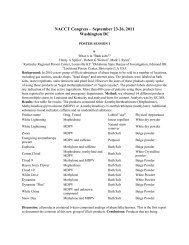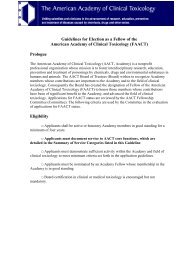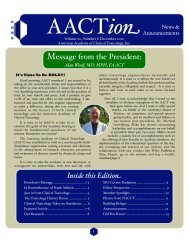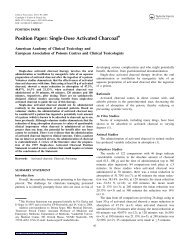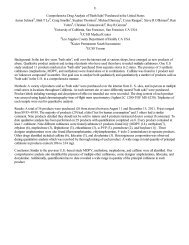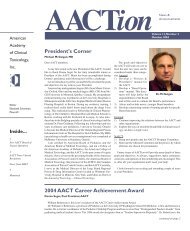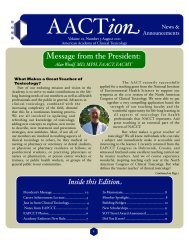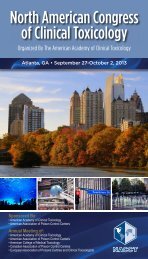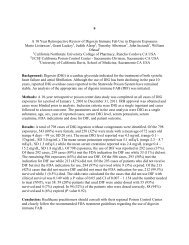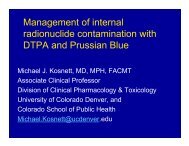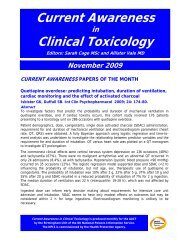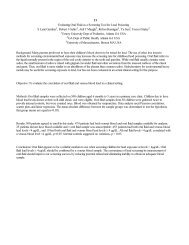Posters IV - The American Academy of Clinical Toxicology
Posters IV - The American Academy of Clinical Toxicology
Posters IV - The American Academy of Clinical Toxicology
You also want an ePaper? Increase the reach of your titles
YUMPU automatically turns print PDFs into web optimized ePapers that Google loves.
Emerg Med<br />
only<br />
81 (38%) 117 (59%) 94 (80%) 70 (85%)<br />
Conclusions: Over the last 35 years there has been a shift in the primary boards <strong>of</strong> medical toxicologists<br />
towards EM. Prior to 1994 38% <strong>of</strong> medical toxicologists had primary boards only in EM, and since the<br />
fellowship requirement began in 2002 this has increased to 85%. Medical <strong>Toxicology</strong> has become a<br />
specialty predominantly <strong>of</strong> EM physicians. Pediatricians account for fewer than one in ten recent MT<br />
diplomates, and the number <strong>of</strong> occupational medicine and internal medicine physicians who have become<br />
board certified in MT since ACGME fellowship training became compulsory is negligible. <strong>The</strong><br />
implication <strong>of</strong> this shift require thoughtful deliberation.<br />
294<br />
Community Partners and National Poison Prevention Week: Lessons Learned<br />
Molly Broderick 1 , Teresa Dodd-Butera 2<br />
1 California Poison Control System, San Diego CA 2 CSU San Bernardino, San Bernardino CA USA<br />
Background: Unintentional poisoning is one <strong>of</strong> the leading causes <strong>of</strong> unintentional injury death in the<br />
United States. Establishing community partnerships for National Poison Prevention Week <strong>of</strong>fers the<br />
opportunity to educate community agencies and the public on prevention strategies, while increasing<br />
awareness <strong>of</strong> Poison Control Centers (PCCs); and presenting community resources for poisoning<br />
emergencies. <strong>The</strong> purpose <strong>of</strong> this qualitative report is to describe the barriers and opportunities<br />
encountered in establishing community partners for disseminating materials and educating the public on<br />
poison prevention. Methods: Selected community organizations were notified prior to National Poison<br />
Prevention Week (2011) about the opportunity to collaborate and celebrate the week <strong>of</strong> educational<br />
activities. Participating organizations involved a youth center, public health departments, health clinics,<br />
and community resource centers. Dissemination <strong>of</strong> educational pamphlets, telephone stickers, and<br />
information sessions were arranged for National Poison Prevention Week. Results: Both obstacles and<br />
opportunities presented themselves in this experience. At the youth center, educational materials were<br />
required to be placed in a designated community section which was in an open area, but not wellrecognized;<br />
and was crowded with other literature. <strong>The</strong>re was no information table or opportunity for a<br />
question and answer session with the CSPI. <strong>The</strong> public health department actually encouraged<br />
dissemination <strong>of</strong> materials and patient interaction, but the numbers <strong>of</strong> encounters were low. <strong>The</strong><br />
community resource center was available to many participants who took advantage <strong>of</strong> obtaining<br />
information pamphlets, but participants were there to receive food stamps, and were somewhat<br />
disinterested in discussing poison prevention. Partnering with the pr<strong>of</strong>essionals was informative, and<br />
allowed for assessment <strong>of</strong> the agency awareness <strong>of</strong> PCC services. It also allowed for outreach to revisit<br />
future partnerships throughout the year. Conclusions: Opportunities were varied for raising awareness and<br />
disseminating poison prevention materials. <strong>The</strong> PCC is an essential source for community information on<br />
treatment and prevention <strong>of</strong> poisonings. National Poison Prevention week <strong>of</strong>fers the opportunity for<br />
outreach and education. <strong>The</strong> lessons learned from the experience include the potential for increasing<br />
awareness <strong>of</strong> PCCs outreach for prevention and services in the community. Barriers presented include the<br />
need for community and client assessment. Partnering with the pr<strong>of</strong>essionals began the assessment <strong>of</strong><br />
agency potential, and established continuing partnerships for further education and collaboration.<br />
295



